1. Foreign direct investments in 2018
This review examines the development of foreign direct investments in 2018. The different sections of the review raise factors that affect the interpretation of the figures. The description of the statistics should also be considered when using the figures.
In terms of foreign direct investments in Finland, 2018 was characterised by enterprise reorganisations of large multinational enterprises. At the end of 2018, the value of Finland's inward FDI was EUR 62.4 billion, which translates to a decline of EUR 12.6 billion from 2017. At the end of 2018, the value of Finland’s outward FDI was EUR 111.7 billion, an increase of EUR 9.4 billion from the year before. In 2018, Finland's profits from inward FDI totalled EUR 2.1 billion on net.
1.1 Data content and purpose of use
The statistics on foreign direct investments mainly depict financial transactions between domestic and foreign units in multinational groups, the assets and liabilities they generate, as well as international corporate acquisitions.
Financial assets and liabilities are netted in direct investments data according to the directional principle by the direction of the control/influence between the direct investor and investment target. Direct investments to Finland describe the capital that a foreign investor has invested directly in an enterprise located in Finland under the investors' control or influence. Correspondingly, direct investments abroad describe the capital that a Finnish investor has invested directly in an enterprise located abroad under the investors' control or influence. Reverse investments, or financial assets of the direct investment enterprise from direct investors and investments between affiliates are considered in the data according to the directional principle. The financial assets and liabilities of affiliates whose ultimate control is located in Finland are netted and recorded as outward direct investments. Correspondingly, the financial assets and liabilities of affiliates whose ultimate control is located abroad are netted and recorded as inward direct investments. Data on direct investments according to the directional principle are published in the statistics on foreign direct investments.
Table 1. Outward FDI

Table 2. Inward FDI

The statistics on foreign direct investments do not, in most cases, describe foreign real investments into Finland. If, for example, a domestic company under foreign control makes a factory expansion investment in Finland and does not receive financing for this directly from a foreign investor, nothing of the value of the factory expansion investment is recorded in the statistics on direct investments. Foreign direct investments are often interpreted too simply as real investments, but this is not often the case according to a study published by the Research Institute of the Finnish Economy (ETLA) in 2014 (ETLA 2014: Topias Leino and Jyrki Ali-Yrkk�: How does foreign direct investment measure real investment by foreign owned companies). Flow-through investments and enterprises' ownership changes do not often lead to real investments in the host country of the investment. Additionally, if international enterprises operating in the country use domestic financing channels to finance their investments, this is not visible as a foreign direct investment. Another challenge for interpreting data on foreign direct investments is created by the heavy concentration of business activities. Several small investments made into growth enterprises disappear into the normal intra-group financing solutions of multinational enterprises.
More about the definitions of the concepts used in this review can be found on the statistics home page: http://www.stat.fi/til/ssij/kas_en.html .
1.2 Global FDI
According to the investment report published by the United Nations Conference on Trade and Development, flows of global FDI decreased by around 17 per cent in 2018 (UNCTAD: World Investment Report 2019). The decrease in investment flows was particularly directed at investments in developed economies. The flows of investments directed at emerging countries remained more or less unchanged, while the investment flows at developed countries contracted sharply, by around 30 per cent. The contraction in the flows is mainly explained by the repatriation of profits accrued by American multinational enterprises in the first half of 2018 and at the end of 2017 due to tax reforms carried out in the United States.
Figure 1. Global flows of direct investments in 2004 to 2018
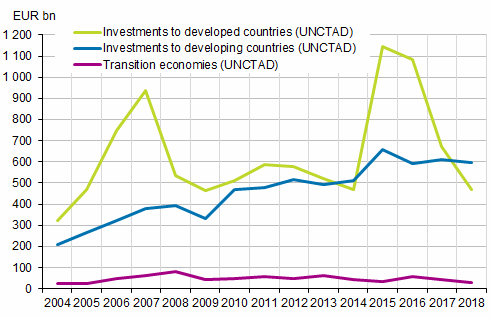
In total, global foreign direct investments amounted to EUR 1,098 billion in 2018, of which EUR 472 billion were directed at developed countries and EUR 598 billion at emerging economies. Examined by country, the USA was the largest host country of direct investments followed by China and Hong Kong. The largest investor countries were Japan, China and France. (UNCTAD 2019.)
The investment report by the United Nations Conference on Trade and Development predicts a moderate 10 per cent growth in global flows of direct investments in 2019, which will, however, be below the average of the past 10 years. The expected growth is based, for example, on the effects from the tax reforms melting away. In addition, announcements of projects creating new activities (greenfield investments) increased in 2018, which also helps support the growth expectations. On the one hand, trade tensions can weaken the growth development of direct investments. (UNCTAD 2019.)
1.3 Finland’s flows of FDI
In 2018, Finland's inward FDI declined when foreign direct investments of EUR -2.1 billion on net were made to Finland, including reinvested earnings. Last time Finland’s inward FDI was negative was in 2013. Examined by country group, a majority of the investments to Finland came from the EU area. Finland’s outward FDI, in turn, grew, as EUR 9.3 billion on net were made in direct investments abroad, including reinvested earnings. Examined by country group, most investments were made in the EU area and North America. Finland’s inward and outward FDI are examined in more detail in Sections 1.4 and 1.5.
Figure 2. Flows of FDI in 2004 to 2018
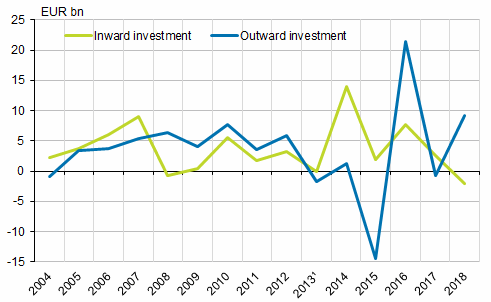
Starting from 2013, the figures are not fully comparable with those for 2004 to 2012 due to changes in the international statistical standard.
1.4 Finland's inward FDI
In 2018, a total of EUR -2.1 billion direct investments were made to Finland on net, which was clearly less than in the two previous years. In 2018, investments in equity-based items were EUR -4.0 billion including reinvested earnings, and EUR 1.9 billion in debt-based items. Negative equity-based investments are partially caused by negative reinvested earnings that depict the difference between the returns accrued and paid. The returns paid to owners of Finland’s inward FDI were EUR 1.4 billion higher than accrued returns in 2018. In addition to negative reinvested earnings, enterprises have returned capital from Finnish enterprises to their home country.
At the end of 2018, the value of FDIs totalled EUR 62.4 billion, of which equity accounted for EUR 56.7 billion and the value of debt capital for EUR 5.7 billion. For listed companies, the value of equity capital is recognised at market value and for other enterprises at book value. In connection with corporate acquisitions, the value of equity is valued based on the market value and the actual transaction price is utilised in determining the market value.
During 2018, the value of FDIs fell by EUR 12.6 billion. The stock of debt-based items increased by EUR 1.8 billion, which is explained by financial transactions. The investment stock of equity-based items, in turn, contracted by EUR 14.4 billion mainly due to classification changes that are recorded in other valuation changes. Classification changes refer to value changes in the stock of financial assets and liabilities, which is not the result of cross-border financial transactions or other changes. Classification changes include, for example, value changes in the stock of financial assets and liabilities as a result of a cross-border change in the enterprise’s domicile and changes caused by enterprise restructuring where an enterprise group organises its internal ownership structure. Changes caused by a change in the type of investment are also recorded in this item. For example, if the voting power entitling to ownership in a foreign investment object falls below ten per cent, the investment no longer fulfils the criteria of a direct investment and it is classified in the balance of payments either as a portfolio investment or other investment.
Table 3. Finland's inward FDI, EUR billion.
| Total | Equity | Debt | |
| Stock of investments 31 Dec 2017 | 75,0 | 71,1 | 3,9 |
| Financial transactions excl. re-invested earnings | -0,7 | -2,6 | 1,9 |
| Re-invested earnings | -1,4 | -1,4 | 0,0 |
| Changes in the exchange rates | 0,0 | 0,0 | 0,0 |
| Other valuation adjustments | -10,5 | -10,5 | -0,1 |
| Stock of investments 31 Dec 2018 | 62,4 | 56,7 | 5,7 |
Examined by country, direct investments have been made to Finland particularly from Sweden (32% of the investment stock), Luxembourg (19%), the Netherlands (17%), Denmark (5%) and Germany (4%). Examined by country group, investments to Finland mainly come from the EU area, whose combined share of the investment stock was 90 per cent in 2018. The share of euro area countries was 50 per cent of the investment portfolio. The shares presented here were calculated according to the immediate investor country. In fact, investments are often managed through an affiliate abroad, in which case the ultimate controlling investor is located in some other country. These figures calculated according to the ultimate investing country are examined in more detail in Section 1.7 of this review.
Figure 3. Direct investments into Finland according to the immediate investor country on 31 December.
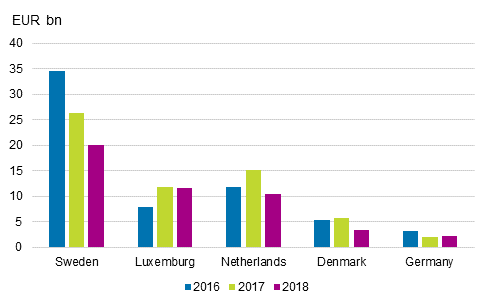
Examined by industry, inward FDI to Finland is particularly directed within services to enterprises engaged in other service activities (39% of the total investment portfolio) and other service enterprises (9%). In manufacturing, most investments have been made in metal industry enterprises (16%) and chemical industry enterprises (12%). Compared to one year ago the biggest drops were seen in manufacturing and service industries. The drop in manufacturing is mainly explained by the sub-category manufacture of computer, electronic and optical products that was EUR 4.5 billion. The sub-category of services, financial and insurance activities decreased by EUR 6.0 billion year-on-year. The industry of the investment is determined based on the industry of the domestic unit. In this case, the share of financing activities increases by arrangements where a Finnish manufacturing enterprise, for example, is managed from abroad through a Finnish holding company classified in the financial sector and established for that purpose.
In 2018, Finland's inward FDI generated total returns of EUR 6.6 billion for foreign investors. A total of EUR 7.6 billion in dividends was recorded in returns and EUR 0.3 billion in interest. EUR -1.4 billion of the returns were reinvested earnings that describe the difference between the returns accrued and paid to owners in a given year. The reinvested earnings of EUR -1.4 billion are also recorded in Finland’s inward FDI (see Table 3).
Returns generated by foreign investors relative to the value of the investment portfolio decreased from the year before. In 2018, returns relative to the value of investments at the end of the year were 10.5 per cent, while in 2017, the rate of return was 10.0 per cent. Most returns in euros were generated to the biggest investor countries, EUR 3.0 billion to Sweden, EUR 1.3 billion to the Netherlands and EUR 0.5 billion to Denmark.
Figure 4. The rate of return of Finland’s inward FDI in 2004 to 2018
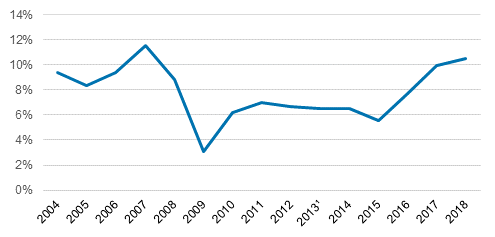
�) Starting from 2013, the figures are not fully comparable with those for 2004 to 2012 due to changes in the international statistical standard.
1.5 Finland's outward FDI
In 2018, outward FDI totalled EUR 9.3 billion on net. Foreign equity investments totalled EUR 1.6 billion on net including reinvested earnings, and debt investments amounted to EUR 7.7 billion on net. In 2018, the net amount of FDI from Finland amounted to EUR 9.3 billion, which was clearly higher than in 2017, when FDI from Finland was EUR -0.7 billion on net. The change in outward FDI is largely explained by an increase in financial transactions with debt-based items.
At the end of 2018, the value of the stock of outward FDI was EUR 111.7 billion, of which equity accounted for EUR 115.4 billion and the value of debt capital for EUR -3.7 billion. The value increase of EUR 9.4 billion in the investment stock is primarily explained by positive development in financial transactions with debt-based items. The biggest change in debt-based items was seen in reverse loan investments. In 2018, classification changes recorded under other valuation changes amounted to EUR 3.0 billion. However, the overall changes in other valuation items were small because the effects of price changes also recorded under other valuation changes was reversed compared to that of classification changes.
Table 4. Finland's outward FDI, EUR bn
| Total | Equity | Debt | |
| Stock of investments 31 Dec 2017 | 102,3 | 113,7 | -11,5 |
| Financial transactions excl. re-invested earnings | 9,2 | 1,5 | 7,7 |
| Re-invested earnings | 0,1 | 0,1 | 0,0 |
| Changes in the exchange rates | 0,5 | 0,2 | 0,3 |
| Other valuation adjustments | -0,4 | -0,1 | -0,2 |
| Stock of investments 31 Dec 2018 | 111,7 | 115,4 | -3,7 |
Examined by country, FDI from Finland is especially directed to the Netherlands (26% of the investment stock), Sweden (20%), Ireland (10%), Denmark (6%) and Norway (4%). Examined by country group, investments are mainly directed to the EU area, whose combined share of the investment portfolio was 80 per cent at the end of 2018. The share of the countries belonging to the euro area in the stock of outward FDI was 50 per cent.
Figure 5. Finland's outward FDI by immediate investor country on 31 December, EUR billion.
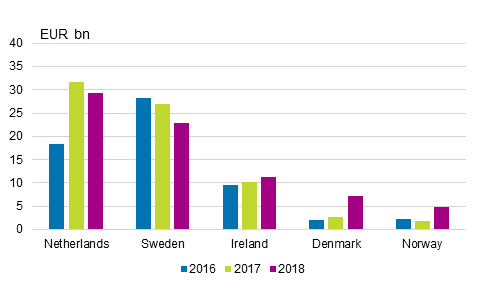
The shares above were calculated according to the country of the immediate investment target. There are no data available on outward FDI according to the country of the ultimate investment target, so it is not possible to give a more exact specification of the final investment target. However, most of the foreign investments are connected to the management of a global enterprise or its part and the actual production activity is located in some other destination country.
The industry of foreign direct investments from Finland is determined based on the industry of the Finnish investor. Examined by industry, Finland’s outward FDI is dominated by manufacturing industries, especially by metal industry (28% of the total investment portfolio) and forest industry (10 %) enterprises. Among service industries, most foreign investments were made by enterprises engaged in financial and insurance activities (22%) and other services (10%). The value of financial and insurance activity enterprises' foreign investments grew by EUR 4.6 billion from 2017 and the value of other industries increased by EUR 3.0 billion. The biggest drop in the investment portfolio by industry was seen in the metal industry, EUR -1.2 billion, the total drop in manufacturing was balanced out by an increase of EUR 1.6 billion in other manufacturing.
Outward FDI generated returns of EUR 8.6 billion in total for Finland in 2018, which is EUR 0.8 billion more than in 2017. Of the 2018 returns, EUR 8.2 billion were dividends, EUR 0.3 billion interests and EUR 0.1 billion reinvested earnings. Dividends received increased by EUR 1.0 billion from the year before. The reinvested earnings of EUR 0.1 billion are also recorded in Finland’s outward FDI (see Table 4).
Returns gained by Finland relative to the value of FDI remained almost on level with the previous year as the rate of return was 7.7 per cent both in 2017 and 2018. Although the stocks of investment have grown, the return relative to the stock has remained unchanged. Measured in euros, most returns for Finland were generated by Sweden, EUR 4.0 billion, the Netherlands EUR 1.2 billion and the United States EUR 0.7 billion.
Figure 6. The rate of return of Finland’s outward FDI in 2004 to 2018

�) Starting from 2013, the figures are not fully comparable with those for 2004 to 2012 due to changes in the international statistical standard.
1.6 Direct investments in the balance of payments
The figures for direct investments according to the directional principle presented in this review differ from the gross figures presented in the statistics on balance of payments and international investment position. The differing statistical method of balance of payments is discussed more in Section 2.2 of the review for the statistical reference year 2013.
At the end of 2018, the value of Finland's inward FDI stock was EUR 62.4 billion and that of outward FDI stock was EUR 111.7 billion. In 2018, the value of the stock of Finland’s inward FDI decreased, while the value of the stock of Finland’s outward FDI increased. As a result of this, the net investment position of direct investments strengthened considerably as the foreign direct investment assets on net increased to EUR 49.2 billion from EUR 27.2 billion the year before. In particular, direct investments improve the net international investment position of the enterprise sector. Net international position connected to direct investments is the same in the statistics on balance of payments and international investment position, although the gross figures of balance of payments differ from the figures presented here according to the directional principle.
Figure 7. Foreign direct investments in 2004 to 2018.
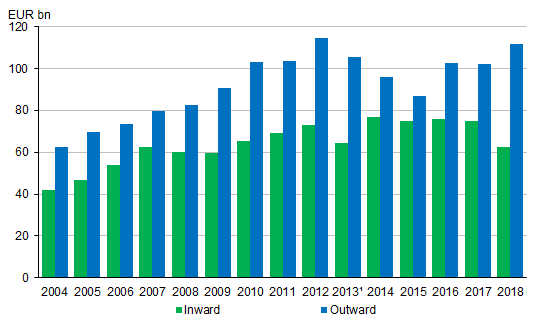
�) Starting from 2013, the figures are not fully comparable with those for 2004 to 2012 due to changes in the international statistical standard.
In 2018, returns on inward FDI amounted in total to EUR 8.6 billion and on outward FDI to EUR 6.6 billion. This property income is recorded in the primary income item of Finland's current account and its net effect on Finland's current account was EUR 2.1 billion in 2018. Net returns from direct investments grew from the previous year, which was due to both a drop in returns paid abroad, that is, direct investments directed to Finland and on the other hand, to an increase in returns paid to Finland. Figure 8 shows that returns connected to direct investments have improved Finland's current account throughout the reference period 2004 to 2018. The net effect of the return from foreign direct investments on the primary income of the current account has fluctuated between EUR 0.4 billion and EUR 4.3 billion.
Figure 8. Returns on FDI in 2004 to 2018.
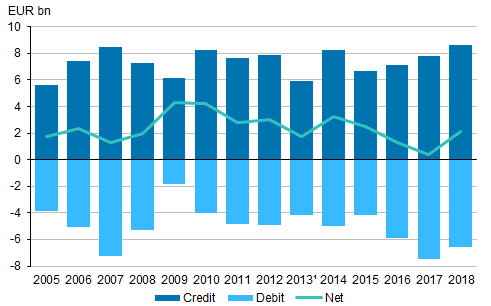
�) Starting from 2013, the figures are not fully comparable with those for 2004 to 2012 due to changes in the international statistical standard.
1.7 Investments according to the ultimate investing country
Direct investments have conventionally been examined only on the basis of the immediate investor country. The new statistical standards and data collected on a more detailed level than before also enable country-specific analyses of direct investments by the ultimate investing country starting from 2013. The ultimate direct investor here refers to the one that is topmost in the ownership chain of the foreign direct investor. The ultimate direct investor is not controlled by any other unit and it can also be a domestic unit.
Figure 9 shows that direct investments to Finland have been made clearly more from Sweden, the Netherlands and Luxembourg if investments are viewed according to the immediate investor country than when the investments are examined according to the ultimate investing country. This indicates that these investments are managed through an enterprise located in these countries, although the actual investor is elsewhere. The opposite is true for the United States, Germany and China. This means that a clearly larger share of FDI into Finland is managed in these countries than made immediately into Finland. When examined by the ultimate direct investor, the share of Finland should also be considered. This is because domestic enterprises own domestic affiliates through their foreign affiliates.
Figure 9. Foreign direct investments to Finland according to the immediate and ultimate investing country, stock of investments on 31 December 2018, EUR billion.
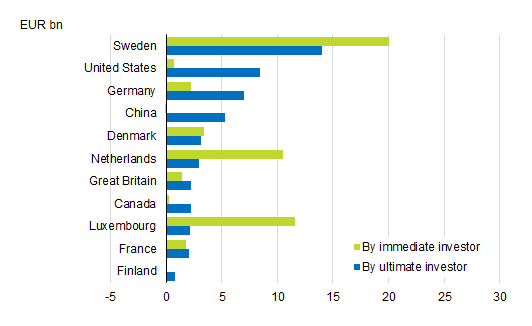
1.8 Investments from Finland, according to the country of the highest controlling owner
It is not possible to compile statistics on Finland's outward FDI by ultimate investing country with the help of the available data sources. However, by examining the ownership chains of enterprises that have made foreign investments from Finland we can examine what proportion of Finland's outward FDI has been made by enterprises that are under Finnish control. The limitation of such an examination is also that it covers only the ownership chain of units in corporate form. For example, the actual owners of a parent company registered in Luxembourg can be Finnish private citizens.
In 2018, the value of Finland's outward FDI was EUR 111.7 billion, of which 90 per cent were held by enterprises under Finnish control. The most significant ultimate investing countries outside Finland were the United States (four per cent) and Sweden (three per cent). When examining investments from Finland, according to the country of the highest controlling owner, Finland cannot be considered a significant pass-through country for direct investments.
Source: Foreign direct investments 2018, Statistics Finland
Inquiries: Roope Rahikka 029 551 3338, balanceofpayments@stat.fi
Director in charge: Ville Vertanen
Updated 30.09.2019
Official Statistics of Finland (OSF):
Foreign direct investments [e-publication].
ISSN=2342-351X. 2018,
1. Foreign direct investments in 2018
. Helsinki: Statistics Finland [referred: 7.1.2026].
Access method: http://stat.fi/til/ssij/2018/ssij_2018_2019-09-30_kat_001_en.html

